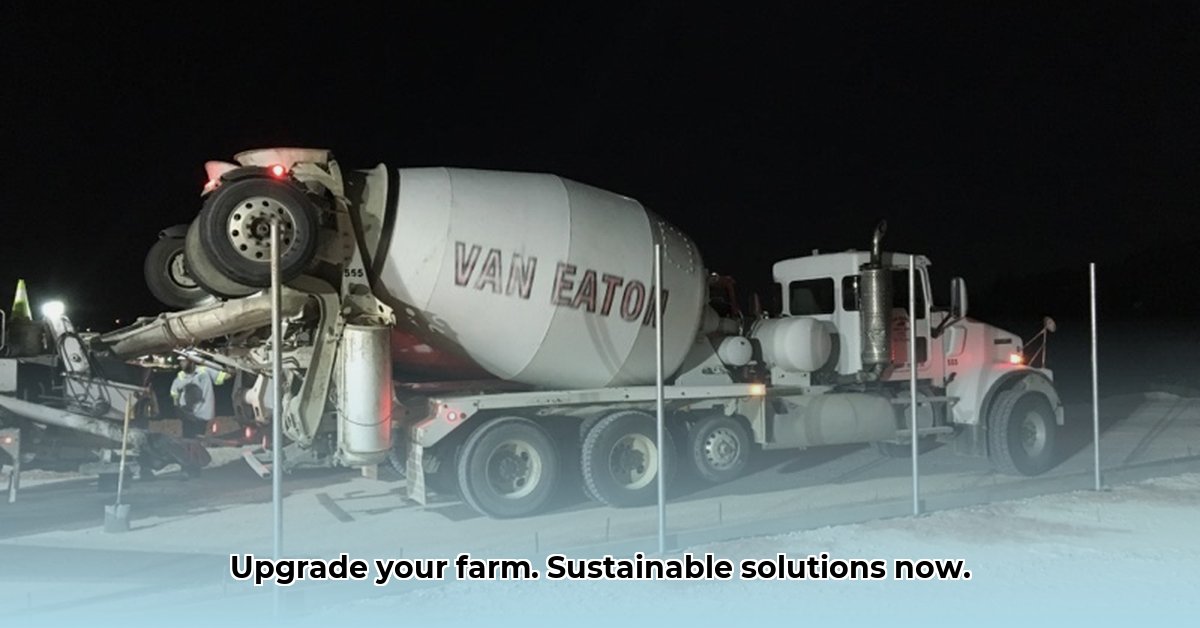
Cement Mixers: A Surprisingly Sustainable Solution for Modern Farming
For years, cement mixers have been a staple in construction, but their potential in sustainable agriculture is only recently gaining recognition. From crafting durable animal shelters to building robust irrigation systems, a cement mixer can significantly improve farm efficiency and environmental responsibility. This article explores how strategically employing cement mixers, particularly those from Tractor Supply, can revolutionize your farming practices, focusing on both the benefits and the necessary considerations for a truly sustainable approach. Check out these durable troughs for inspiration!
Imagine a farm where strong, water-resistant walkways prevent mud and minimize animal stress. Picture custom-built, durable feeding troughs that reduce water waste and improve animal health. Or consider the solid foundation concrete provides for efficient irrigation systems, ensuring consistent water delivery to your crops, leading to higher yields. A cement mixer empowers you to create these solutions, tailoring them precisely to your farm’s unique needs. But how do you choose the right mixer, and how do you minimize the environmental impact of your concrete projects?
Choosing Your Cement Mixer: Finding the Perfect Fit for Your Farm
Selecting the right cement mixer is crucial for efficiency and cost-effectiveness. The ideal choice depends entirely on your project scale and specific requirements. Are you constructing small walkways or tackling a major barn renovation? This choice will dictate the necessary mixing capacity and power source.
Consider these key factors:
- Mixing Capacity: Larger projects demand higher capacity mixers to save time and effort. Smaller projects can be handled by more compact models.
- Power Source: Electric mixers offer quieter and cleaner operation, while gas-powered mixers provide greater power for heavy-duty tasks. Your choice should reflect the typical demands of your farm.
- Portability: A portable mixer grants greater flexibility, ideal for diverse projects around your property. Stationary options are better suited for one location.
- Durability: A robust mixer will withstand years of harsh weather conditions and heavy use, representing a sound, long-term investment.
- Budget: Cement mixers vary significantly in price; set a realistic budget to guide your purchasing decision.
Sustainable Choices: Minimizing the Environmental Footprint of Concrete
While concrete provides unparalleled durability, its production is energy-intensive and generates greenhouse gas emissions. However, it doesn't have to be environmentally damaging. With mindful choices, you can significantly reduce its impact.
- Eco-Friendly Cement Alternatives: Research low-carbon cement options, many of which are now available. These cements offer comparable strength with reduced emissions.
- Recycled Aggregates: Incorporate recycled materials like crushed concrete or recycled glass into your concrete mix. This diverts waste from landfills and reduces demand for virgin materials, directly lowering the carbon footprint.
- Responsible Waste Management: Proper disposal of leftover concrete is crucial. Plan for responsible waste management—recycling where possible—to lessen the environmental burden. "Reducing our concrete's environmental impact is a continuous process," says Dr. Anya Sharma, Environmental Engineer at the University of California, Berkeley. "Each conscious decision moves us closer to sustainable building practices."
Investing in a Sustainable Future: Long-Term Benefits and Holistic Approach
Investing in a durable concrete structure built with a cement mixer is an investment in your farm's future. These structures require less maintenance and fewer repairs over their lifespan, leading to long-term cost savings, which directly improve your farm's bottom line. This economic benefit aligns perfectly with sustainable farming's core principles. But sustainable agriculture is more than just materials; it's a change in perspective.
"Sustainable farming requires a holistic view," explains John Miller, a seasoned farmer and advocate for sustainable practices. "From selecting materials to managing waste, every decision should reflect environmental stewardship.”
Let's examine the interconnectedness of stakeholders:
| Stakeholder | Short-Term Actions | Long-Term Goals |
|---|---|---|
| Farmer | Adopt low-carbon cement alternatives; implement efficient waste management strategies. | Integrate sustainable building and operational plans; continuously strive for improvement. |
| Supplier | Stock and promote eco-friendly options; offer educational resources on building practices. | Collaborate with manufacturers to expand the availability of sustainable materials and technologies. |
| Researcher | Develop low-impact concrete formulations; investigate ways to reduce cement's carbon footprint. | Create innovative, low-impact concrete products and construction methods. |
| Policy Maker | Implement incentives for using sustainable materials and waste management; establish clear environmental guidelines. | Encourage sustainability in agriculture and construction via policy and regulations. |
Reducing the Carbon Footprint: Practical Steps for a Greener Concrete Mix
Cement production itself is a considerable source of CO2 emissions, yet there are actionable steps you can take. As Dr. Emily Carter, Professor of Chemical Engineering at Princeton University, notes, "Reducing the carbon footprint requires a multi-pronged strategy." These factors include the energy demands of manufacturing, the transportation to your farm, and the inherent CO2 release during the chemical process. Here's how we can minimize this impact:
- Source Low-Carbon Cement: Prioritize cements with lower CO2 emissions per unit of concrete produced.
- Minimize Cement Use: Utilize concrete mixes that use less cement without compromising structural integrity.
- Optimize Mixing Practices: Properly maintain your cement mixer to improve energy efficiency and reduce waste.
- Embrace Recycled Materials: Incorporate recycled aggregates to reduce landfill waste and demand for virgin resources.
- Reduce Transportation: Purchase locally sourced cement to minimize transportation emissions.
- Carbon Offset Programs: Consider offsetting unavoidable emissions by investing in reputable carbon offset programs.
By actively selecting more sustainable materials, optimizing your mixing and construction processes, and engaging in responsible waste management, you can contribute significantly to a greener future for your farm and the environment as a whole. Remember, sustainable farming is an ongoing journey, and every conscious decision counts.